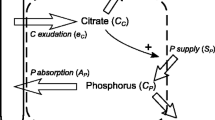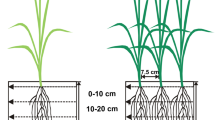Abstract
We have observed that low soil phosphorus availability alters the gravitropic response of basal roots in common bean (Phaseolus vulgaris L.), resulting in a shallower root system. In this study we use a geometric model to test the hypotheses that a shallower root system is a positive adaptive response to low soil P availability by (1) concentrating root foraging in surface soil horizons, which generally have the highest P availability, and (2) reducing spatial competition for P among roots of the same plant. The growth of nine root systems contrasting in gravitropic response over 320 h was simulated in SimRoot, a dynamic three-dimensional geometric model of root growth and architecture. Phosphorus acquisition and inter-root competition were estimated with Depzone, a program that dynamically models nutrient diffusion to roots. Shallower root systems had greater P acquisition per unit carbon cost than deeper root systems, especially in older root systems. This was due to greater inter-root competition in deeper root systems, as measured by the volume of overlapping P depletion zones. Inter-root competition for P was a significant fraction of total soil P depletion, and increased with increasing values of the P diffusion coefficient (De), with root age, and with increasing root gravitropism. In heterogenous soil having greater P availability in surface horizons, shallower root systems had greater P acquisition than deeper root systems, because of less inter-root competition as well as increased root foraging in the topsoil. Root P acquisition predicted by SimRoot was validated against values for bean P uptake in the field, with an r 2 between observed and predicted values of 0.75. Our results support the hypothesis that altered gravitropic sensitivity in P-stressed roots, resulting in a shallower root system, is a positive adaptive response to low P availability by reducing inter-root competition within the same plant and by concentrating root activity in soil domains with the greatest P availability.
Similar content being viewed by others
References
Baldwin J P and Nye P H 1974 A model to calculate the uptake by a developing root system or root hair system of solutes with concentration variable diffusion coefficients. Plant Soil 40, 703–706.
Barber S A 1995 Soil Nutrient Bioavailability: a Mechanistic Approach. Wiley-Interscience. New York
Berntson G M 1994 Modelling root architecture: are there tradeoffs between efficiency and potential of resource acquisition? New Phytol. 127, 483–493.
Bonser A M, Lynch J and Snapp S 1996 Effect of phosphorus deficiency on growth angle of basal roots in Phaseolus vulgaris.New Phytol. 132, 281–0288.
Claassen N and Barber SA 1976 Simulation model for nutrient uptake from soil by a growing plant system. Agron. J 68, 961–964.
Clausnitzer W and Hopmans JW 1994 Simultaneous modeling of transient three-dimensional root growth and soil water flow. Plant Soil 164, 299–314.
Diggle A J 1988 ROOTMAP-A model in three-dimensional coordinates of the growth and structure of fibrous root system. Plant Soil, 105: 169–178
Doussan C, Pages L and Vercambre G 1998 Modelling of the hydraulic architecture of root systems: an integrated approach to water absorption-model description. Ann. Bot. 81 213–223.
Eissenstat D M 1997 Trade-offs in root form and function. In Ecology in Agriculture. Ed. L E Jackson. pp 173–199. Academic Press, San Diego, CA
Espeleta J F and Eissenstat D M 1998 Responses of citrus fine roots to localized soil drying: a comparison of seedlings with adult fruiting trees. Tree Physiol. 18, 113–119.
Evans M L 1991. Gravitropism: interraction of sensitivity modulation and effector redistribution. New Phytol. 106, 61–77.
Fitter A H 1987 An architectural approach to the comparative ecology of plant root systems. New Phytol. 95,1–5.
Fitter A H. 1991. Characteristics and functions of root systems. In Plant Roots: the Hidden Half. Eds Y Waisel, A Eshel and U Kafkafi. pp 3–25. Marcel Dekker, New York.
Fitter A H, Stickland T R, Harvey ML and Wilson GW1991 Architectural analysis of plant root systems I: Architectural correlates of exploitation efficiency. New Phytol. 118, 375–382.
Gourley C J P, Allan D L and Russlle M P 1994 Plant nutrient effi-ciency: a comparison of definitions and suggested improvement. Plant Soil 158, 29–37.
Hackett C and Rose D A 1972 A model of the extension and branching of a seminal root of barley, and its use in studying relations between root dimensions. 1. The model. Aust. J. Biol. Sci. 25, 669–679.
Jungk A and Claassen N 1997 Ion diffusion in the soil-root system. Adv. Agron. 61, 53–110.
Keter K J A and Ahn P M 1986 Profile characteristics, and form and surface activity of inorganic phosphorus in a deep red Kenya coffee soil (Nitosol). J. Soil Sci. 37, 89–97.
Lynch J P 1995 Root architecture and plant productivity. Plant Physiol. 95, 7–13.
Lynch J P and Beebe S E. 1995. Adaptation of beans (Phaseolus vulgaris L.) to low phosphorus availability. HortScience 30, 1165–1171.
Lynch J P and Nielsen K L 1996 Simulation of root system architecture. In Plant Roots: the Hidden Half. Eds Y Waisel, A Eshel and U Kafkafi. pp. 247–257. Marcel Dekker, New York.
Lynch J P and van Beem J 1993. Growth and architecture of seedling roots of common bean genotypes. Crop Sci. 33, 1253–1257.
Lynch J P, Epstein E, Lauchli A and Weigt G 1990 An automated greenhouse sand culture system suitable for studies of P nutrition. Plant Cell Environ. 13, 547–554.
Lynch J P, Nielsen K L, Davis R D and Jablokow A G 1997 Sim-Root: modelling and visualization of botanical root systems. Plant Soil 18, 139–151.
Lungley D R 1973 The growth of root systems. A numerical computer simulation model. Plant Soil 38, 145–159.
Nielsen K L, Lynch J P, Jablokow A G and Curtis P S 1994. Carbon cost of root systems: an architectural approach. Plant Soil 165, 161–169.
Nielsen, K L, Bouma T J, Lynch J P and Eissenstat D M 1998 Effects of phosphorus availability and vesicular-arbuscular mycorrhizas on the carbon budget of common bean (Phaseolus vulgaris). New Phytol. 139, 647–656.
Nye P H and Foster WN M 1961 The relative uptake of phosphorus by crops and natural fallow from different parts of their root zone. J. Agric. Sci. 56, 299–306.
Nye P H and Tinker P B 1977 Solute movement in the soil-root system. University of California Press, Berkeley. 342 p.
Oyanagi A, Sato A and Wada M 1991 Varietal differences in geotropic response of primary seminal root in Japanese wheat. J. Crop. Sci. 60, 312–319.
Pages L, Jordan M O and Picard D 1989 A simulation of the threedimensional archtecture of the maize root system. Plant Soil 119, 147–154.
Pothuluri J V, Kissel DE, Whitney D A and Thien S J 1986 Phosphorus uptake from soil layers having different soil test phosphorus levels. Agron. J. 78, 991–994
Sadeghian S 1991 Influencia de algunas caracteristicas de las semillas y plantulas de frijol Phaseolus vulgaris L. sobre la tolerancia a la baja disponibilidad de fosforo en el suelo. Trabajo de grado Univ. Nac. Colombia, Palmira. 70 p.
Schenk M K and Barber S A 1979 Phosphate uptake by corn as affected by soil characteristics and root morphology. Soil. Sci. Soc. Am. J. 43: 880–830.
Smethurst P J and Comerford N B 1993 Simulating nutrient uptake by single or competing and contrasting root systems. Soil Soc. Am. J. 57, 1361–1367.
Somma F, Hopmann J W and Clausnitzer V 1998 Transient threedimensional modeling of soil water and solute transport with simultaneous root growth, root water and nutrient uptake. Plant Soil 202, 281–293.
Stoffella P J, Sandstead R F, Zobel R Wand Hymes WL 1979 Root characteristics of black beans, II. Morphological differences among genotypes. Crop. Sci. 19, 826–830
Author information
Authors and Affiliations
Rights and permissions
About this article
Cite this article
Ge, Z., Rubio, G. & Lynch, J.P. The importance of root gravitropism for inter-root competition and phosphorus acquisition efficiency: results from a geometric simulation model. Plant and Soil 218, 159–171 (2000). https://doi.org/10.1023/A:1014987710937
Issue Date:
DOI: https://doi.org/10.1023/A:1014987710937




